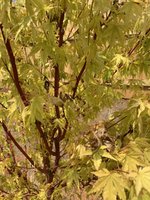While it doesn't rain every day in Japan, they average double the amount of rain the US gets. and during monsoon/typhoon season, it rains literally every day... I didn't see anything on your initial post about location, which is why I said it was a blanket statement without including the location and how to adjust to it. Another thing to consider is the kind of soil in the area. While TN have good soil, what I have here in TX sucks... GA (most of the places I have been to) is mostly red clay, which is not the best for Maples as well.
I have2 maples that I ordered from MrMaple, one died a few months back on a hail storm, and the nursery mix they use bogs down a lot. It is the wettest from all the trees that I have ordered or bought from nurseries locally. Way too much peat moss for my liking... but maybe that is because they adjust the mix so hold more water during the shipping process.
I’m not sure exactly why JM thrive in the monsoons of Japan when they would potentially fail here, although I’m pretty certain it would have a lot to do with the components of their native soil and that JM can tend to have a shallow root system.
Soils in TN can vary greatly, but here in middle TN it is predominantly red clay (garbage) and limestone -big part of why how you plant, water, and what soil amendments used here is so important. We are definitely not sitting on a volcano here, it’s a clay basin.
Hate to hear that about your JM. At the nursery I work at there is some peat in the mix, but also a stronger ratio of sand and pine bark soil conditioner. This is pretty much the same type mix as trees we receive from Oregon except they have pumice and less or no sand. If had to guess, Mr. Maple have such a heavy ratio of peat because they would have to water nonstop given the amount of stock they have otherwise.
Still though, even with the more freely draining mixes we use at work, watering the JM’s every day really can be very detrimental to them (kill them). I treat them more akin to the conifers regarding watering rather than like other the other deciduous. If we used a more porus free-draining (better) soil mix, all I would likely ever do is water plants.
What I said in first post here regarding location was this:
Your JM needs to dry out some allowing air to its roots and to encourage roots to grow and search for water. Location and weather conditions are pivotal to when a tree should be watered, but virtually no tree or shrub in the ground or in a pot needs to be watered every day, they should only be watered when the tree needs water.
Regarding planting a Coral bark in full sun I’ve seen some thrive and some not. The best thing if you have to do it and succeed would be to plant it right and water it right. Dig the hole much wider than the diameter of the pot (~3x+), use a good soil amendment suited to your area that can drain, water when the tree needs it even if it’s established.
A weak coral bark in full sun could be weak because it’s not getting enough water to facilitate cooling itself off. This is especially important in summer. Trees don’t sweat, they have to pull water through their vascular system to cool off. If there is no more water to cool the tree it gets crispy and loses leaves -it’s not always that the leaves or the tree just can’t handle the amount of hrs of direct sunlight or about photosynthesis.







